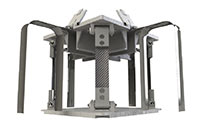CubeSat-based Ionospheric Sounders
 The ionosphere is an ionised region of the upper atmosphere ranging in altitude from approximately 90 to 1600 km.
The ionosphere is an ionised region of the upper atmosphere ranging in altitude from approximately 90 to 1600 km.
Variations in the density of the electrons in the ionosphere can disturb the passage of radio signals, creating difficulties for some communications and imaging applications.
The impact of the ionosphere increases as frequency is reduced and most radio systems that operate between the ground and space at frequencies below 2 GHz can be affected. There is a need to measure the wideband ionospheric radio channel. This can be achieved by transmitting a signal from a satellite and receiving it on the ground. However, the development of antenna suitable for this application and that can be deployed on a cubesat is challenging.
Our approach
WISCER (Wideband Ionospheric Sounder CubeSat Experiment) is being developed to provide such a wideband signal in space. The overall project is led by the Poynting Institute at the University of Birmingham, whilst the University of Glasgow is developing an innovative antenna system. The antenna must provide a smooth gain pattern over a wide beamwidth (to reduce the pointing requirements on the satellite), a smooth response over the required bandwidth (approximately 100 MHz at P Band), circular polarisation, and be relatively efficient. These requirements lead to the need for a large (compared to the size of cubesat) antenna, that must therefore be deployed once the satellite is in orbit. The antenna will comprise a crossed bent dipole deployed over a ground plane.
Why is this research important?
The impact of the WISCER mission is threefold:
- The mission will provide measurements of the ionospheric channel that are crucial for the design of future, low frequency, space-based radars.
- The mission will extend UK capability in deployable space structures; in particular where those structures enable the use of relatively large antennas on very small satellites. Such antennas are required for other possible missions such as radio spectrum monitoring.
- The mission will develop beacon techniques that may be used for in other frequency bands (i.e. for future C-band navigation systems).

